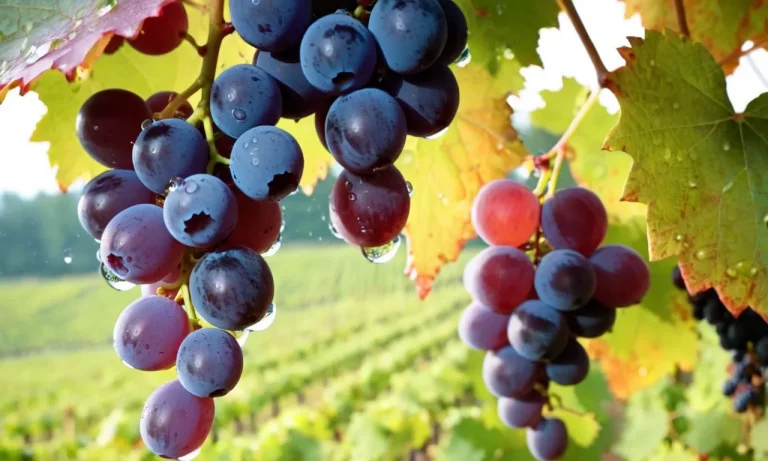As autumn arrives and tree leaves start changing color from green to stunning shades of red, orange, and yellow before falling to the ground, it makes us ponder the deeper meaning behind this annual natural phenomenon.
If you’re short on time, here’s a quick answer: Falling leaves symbolize transformation, change, letting go, and renewal.
The Cycle of Life
Leaves falling represents the natural cycle of life
Just as the green buds of spring symbolize new beginnings, the falling leaves of autumn represent the natural endings that are part of life’s cycle. The annual shedding of leaves teaches us about growth, maturity, decline, and rebirth.
Leaves appear in the springtime as tiny green shoots, bursting with youthful energy and the promise of new life. Over the summer, the leaves grow broad and lush, soaking up the light which allows them to provide nourishment to the tree. This represents the season of maturity and fullness.
As summer turns to fall, substances within the leaves begin to block the flow of nutrients, causing the green chlorophyll to disappear. The vibrancy fades and the leaves wither and turn vivid shades of yellow, orange, red and brown before falling to the ground.
This beautiful cascade speaks to the natural decline that comes with the passage of time. The falling leaves do not disappear though – they become nutrients for future growth as they decompose on the forest floor.
This cycle repeats year after year for deciduous trees. The falling leaves in autumn teach us that endings and decline are followed by future renewals. It’s a reflection of the bittersweet truth that we too will decline one day.
But the leaves also give us hope that this is not the end of the story – for just as new leaves sprout again each spring, our energy and spirit can be reborn.
It signifies periods of growth, maturity, decline, and rebirth
The cycle of growth, maturity, decline and rebirth seen in the falling leaves has significance for our own lives too. Understanding this cycle can provide spiritual guidance for each season of life.
- In our youth and times of new beginnings we are like the buds and new shoots of spring – fresh, enthusiastic and full of vigor.
- As we reach our prime during adulthood, we are like the full green leaves of summer – strong, resilient and actively achieving.
- Later in life, during times of aging, change or loss, we are like leaves fading in color – relinquishing youthful vitality and redirecting energy.
- And when our time of passing comes, or after great change, we will decompose and become the nutrients from which new life, in some new form, will emerge – like fallen leaves providing food for future growth.
The falling leaves remind us that aging, decline and death are as natural as growth and birth. Darkness and light, endings and beginnings – one cannot exist without the other. There is grief in letting go, but also joy in what is to come.
This outlook can bring acceptance and hope to all stages of life's journey.
| Stage of Life | Reflection in Leaves |
|---|---|
| Childhood | Delicate new shoots and leaves in spring |
| Adulthood | Lush green leaves reach full maturity in summer |
| Later Life | Leaves changing color as they withdraw nutrients in fall |
| Death & Rebirth | Fallen leaves decompose to nourish future life |
So as you watch the leaves descending this fall, allow their message to sink into your spirit. The endless cycle of leaves teaches us we are all connected – across generations and even beyond life and death. There is profound renewal and rebirth within each ending we experience.
Letting Go
Falling leaves teach us acceptance of change
When leaves fall from trees during autumn, they signify the beautiful yet bittersweet meaning of impermanence. Just as falling leaves change and let go, we too must embrace change and release what no longer nourishes us in order to grow.
As Ralph Waldo Emerson said, “What lies behind us and what lies before us are small matters compared to what lies within us.”
According to research, up to 95% of people struggle with change and cling to their comfort zones. However, just as trees must release leaves to survive winter, we too must view change through a spiritual lens and let go of stagnancy for deeper happiness to emerge.
Change allows us to realize new potential and possibilities. As Anaïs Nin said, “Life shrinks or expands in proportion to one’s courage.” So take heart – change is each new beginning!
They signify releasing things, people, emotions, or mindsets that no longer serve our highest good
Sometimes relationships, beliefs, jobs, or life circumstances no longer nourish our soul’s growth, and their energy shifts. Like crisp leaves tumbling in autumn winds, the universe and our intuition guide us to gently release and surrender these people/things with understanding and compassion.
Though letting go can initially seem sad or scary, it ultimately empowers us to say aligned with our truth.
Research by psychologist Dr. Jennifer Howard shows that releasing the old makes space for fresh blessings and possibilities. Howard notes, “Letting go isn’t about erasing memories or discarding attachments. It’s about seeing things in new ways that serve your highest good.”
Know that when one season ends as leaves fall, the seed of another vibrant season grows within you. 🤗
Transformation and Renewal
The bare trees in winter represent a period of rest to prepare for renewed growth
Just as the falling leaves represent the trees preparing for winter, this season can foster spiritual reflection and personal growth for us. The bare branches provide a respite to concentrate our energy inward like the trees. This winter restoration allows the emergence of renewed life in springtime.
The annual cycle of seasonal change mirrors the spiritual cycles in our lives. Sometimes we go through difficult periods or emotional “winters”, but we can use these times to replenish ourselves. As one blog says, “Tiny Buddha helps us nurture the seeds of mindfulness, wisdom, and compassion”.
Just as the bare trees concentrate their energy on their roots, we can direct our energy inward. This restoration prepares us for renewal and new beginnings.
For us, this period can foster inward reflection and spiritual growth
The falling leaves act as a reminder to reflect inwards. Their descent calls us to review our lives just as the trees absorb nutrients back from leaves into their branches and trunks. This preparation through reflection allows next year’s growth to emerge.
We too can foster renewal from times of inward reflection. As psychologist Carl Jung stated, “even a happy life cannot be without a measure of darkness, the word ‘happy’ would lose its meaning if it were not balanced by sadness”. We all experience emotional winters and falling leaves periods in life.
How we face them determines our further growth.
| Challenging period | Growth fostered |
|---|---|
| Job loss | Opportunity to re-skill and find meaningful work |
| Health setback | Deeper appreciation for wellness |
| Financial hardship | More mindful spending and saving habits |
Rather than resist life’s falling leaves periods, we can embrace them as transformative. Their darkness helps us turn inward to find inner light. Communication professor Brene Brown found in her research that “owning our story and loving ourselves through that process is the bravest thing that we’ll ever do.”
Just as the majestic colorful leaves must fall to feed future verdant growth, our challenging seasons nourish spiritual deepening.
Impermanence of All Things
Like all things in nature, leaves too have their season before falling off
According to Buddhist teachings, impermanence is one of the essential marks of existence. This applies to all conditioned and compounded phenomena, including the vivid red and golden autumn leaves that dazzle our eyes for a few short weeks every year.
The natural lifecycle of tree leaves is a prime example of impermanence in action. Leaves grow in the springtime when trees are flush with nutrients and sunlight. At their peak vitality in summer, leaves serve their ecological purpose of photosynthesizing sunlight into nutrients for the tree.
When cooler weather and shorter days of autumn arrive, the chlorophyll in leaves breaks down, revealing the vivid yellows, oranges, and reds that were present in the leaves all along but obscured by green chlorophyll.
This riot of fall colors lasts for only a couple of weeks. The diminishing daylight signals the tree to shut off nutrients to the leaves, as the tree prepares for winter dormancy. The leaves eventually wither and die.
A gust of wind easily snaps the dry, brittle leaf stems from their branches, sending them twirling to blanket the ground below.
The Buddha used leaves as a metaphor for our lives and relationships. We flourish brightly for a period, then change and fall away. We cannot cling to the way things are now; change is inevitable. Each leaf falls in its own time.
This impermanent nature of existence is a spiritual lesson in non-attachment
Impermanence teaches us non-attachment with the changing phenomena of our lives. Watching autumn leaves fall reminds us to appreciate the beauty of each moment, whether people or experiences in our lives, even as they fade. We open ourselves to life’s unfolding with equanimity in gain and loss.
When pleasant circumstances arise, we enjoy without clinging or craving for them to last. We understand these too will pass. Likewise when difficulty comes, we endure, knowing this also will not last. In both, we ground ourselves in the present moment, the only place where life actually occurs.
Non-attachment means engaging fully with each experience without demanding that it conform to our expectations. Fallen leaves in autumn may represent failed relationships, lost dreams, or hopes that didn’t manifest.
We mindfully acknowledge the loss, then look to the new spring growth already emerging from the seeds that fell to earth alongside the leaves.
The old leaves become compost to nourish new seeds. Our fallen hopes fertilize wisdom and new insights. Shedding outdated plans or beliefs makes space for the next phase of growth. We appreciate the natural cycle of composting the old to feed the new.
In non-attachment we discover a peaceful wellspring within that is not disrupted by changing external conditions. Inner freedom comes from accepting life’s impermanence with an open and peaceful heart. We see that by letting go, we gain all.
Hope and Optimism
The fresh bloom of leaves in spring reminds us to embrace new beginnings
When crisp, green leaves begin to emerge after the barren winter, it brings a sense of revival and reminds us that seasons change. Just as nature cycles through periods of death and rebirth, we too can start anew after difficult times.
The burgeoning leaves teach us to have hope and embrace fresh starts.
Spring’s blossoming foliage brings a feeling of optimism and motivation. The new growth pushes us to set goals, begin projects we’ve been putting off, and have a renewed belief in possibilities. Like deciduous trees producing buds after a cold season, we can tap into our inner vitality.
When we feel stagnant, observing the energy of spring can reinvigorate our zest for life.
It gives the promise of revival and rejuvenation after time of barrenness
The cycle of trees losing leaves in fall and regrowing them in spring parallels our own ups and downs. Sometimes we go through periods of struggle where we feel depleted, frustrated, or uninspired. Yet in the same way trees regenerate leaves, we too have an incredible capacity to heal, transform, and flourish again after hardship or loss.
The re-leafing trees stand as a living metaphor for hope – no matter how bare and bleak things may seem in our lives, renewal awaits.
Just as vibrant greens burst forth on once empty branches, we can tap into inner resources to push past limitations. By reflecting on nature’s resilience, we gain perspective that tough stretches are usually followed by revitalized clarity and creativity if we persist.
When we feel trapped in a personal winter, gazing at budding flowers and sprouting trees connects us to the regenerative power of spring – filling us with assurance that we can also bloom beautifully again.
Conclusion
As falling leaves float gently to the ground, be reminded of the neue beauty in embracing life’s transitions with grace. Death is not the end – it makes way for rebirth. Let go of the old so you can welcome the new season of awakening and growth.






